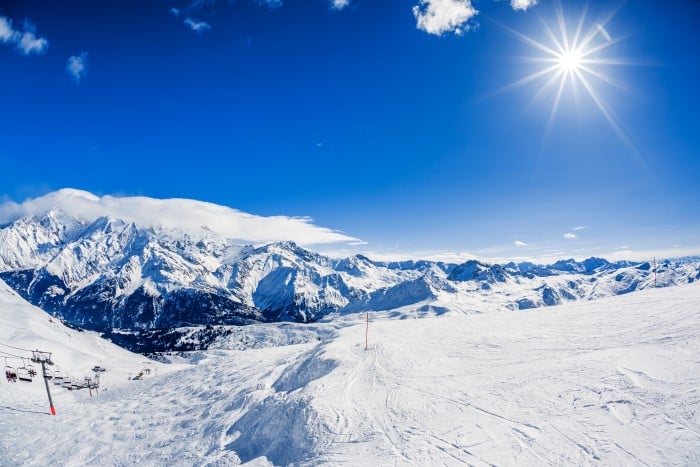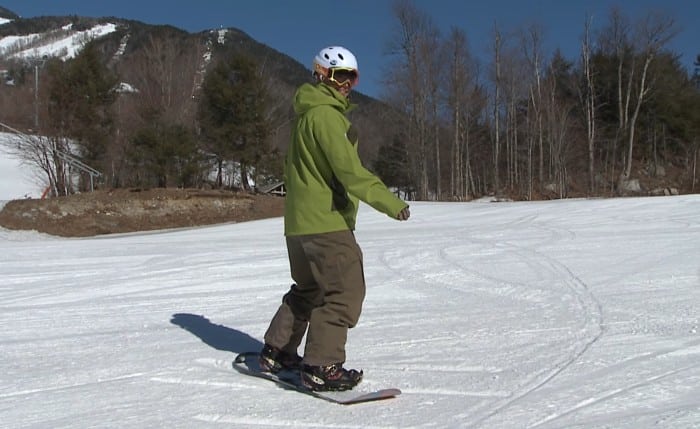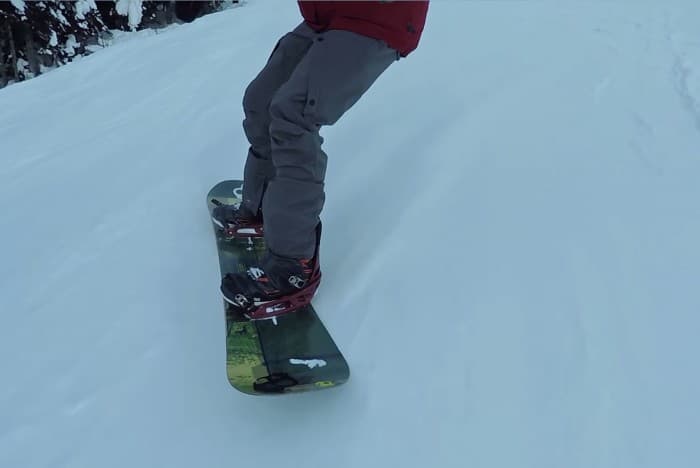When snowboarding, you might find yourself coming across a patch of ice on the run, and you may panic about what to do with the ice that’s essentially taking you and your board hostage, putting you at risk of falling over.
The best way to snowboard on the ice is to have sufficiently sharp edges, a full camber board, and a board with serrated edges while keeping your edges at a low angle. You need to have proper balance, posture, and relaxation, and to potentially learn how to do slarve turns.
It isn’t easy to snowboard on the ice, as the ice forces you to relinquish all control you had over the board and be at its whims. However, there are ways to snowboard effectively on the ice and avoid the potential injury that might come with it.
Tips to Keep in Mind
Ice is very distinct from snow. Even at a distance, the bluish-gray hue of ice will stand out from the nice, powdery white of the snow.
If you can help it, try to avoid the ice as best as possible.
However, if you can’t avoid the ice, you’ll most definitely be able to detect it by hearing the scratchy noise that comes with snowboarding on ice, or you’ll be able to feel the loosening of your grip on the board.
If you’re having trouble seeing the ice, then try to ride to the side of the piste, as ice on runs is generally caused by people shredding and knocking away the layers of snow that may be on top.
Alternatively, look for gentler slopes that you can go slower on, as there’ll be less opportunity for the snow to get knocked away and end up revealing ice underneath.

The Gear Needed to Snowboard on Ice
To properly snowboard on ice, you need to be set up with specific gear equipped to handle the rough conditions that come with icy terrain.
Without it, you could be left struggling as you slide around on the ice, unable to gain complete control of your board.
1. Ensuring Your Edges are Sharp
When snowboarding on ice, you need to have sharp edges to manage the slippery terrain adequately.
The sharper edges will be able to tear into the ice and gain traction much more easily than if they were dull.
To check if your edges are sharp, you need to scrape your fingernail against the edges.
If you see bits of your nail coming off, or if your nail begins to peel, then your board is sufficiently sharp and will be able to handle the icy terrain.
If you rub it only to find that it feels dull and rounded out, you will need to sharpen your snowboard’s edges.
2. Sharpening Your Snowboard’s Edges
Sharpening your snowboard’s edges is a regular part of tuning up and maintaining your snowboard so that it can take care of you.
If you need to sharpen your snowboard, you could take it to a snowboard repair business and let them do the busy work for you.
Alternatively, if you’d like to do it yourself, you can purchase a snowboard repair kit and follow the instructions as laid out within it.
3. Different Board Types Needed to Shred on Ice Safely
When looking for a board that can handle the ice, you’ll want to look for two things: full camber and Magne-traction.
Full Camber Boards
Full camber refers to the bending of the snowboard in its center. With a full camber, your snowboard will have a shape, also known as a profile, to maximize its effective edge.
The effective edge of a snowboard refers to the edge that makes contact with the snow when riding.
Having a maximized effective edge allows you to better control your board in rough conditions, such as ice, and better control the board when it’s moving down the mountain at quick speeds.
Magne-traction Boards
Magne-traction refers to the type of edge you have on your snowboard.
Magne-traction features wavy bumps on the edge of the board that works like a serrated knife, cutting into any ice as you go down the mountain.
It allows you to gain better control over your board in icy conditions and creates an overall more pleasant riding experience.
With a board with full camber and Magne-traction, you’ll have the easiest time possible when snowboarding on ice, as the both of them work exceptionally well together in slicing through patches of ice as you’re riding down the mountain.
The Technique Behind Snowboarding on Ice
While having the proper gear is a massive part of the snowboarder’s battle against the ice, it’s only half the battle, as technique plays a huge role in being able to shred against the ice.
You can have the best gear in the world, but without proper technique, you will be left with no progress made snowboarding down the icy mountains.
1. The Core Components Behind Any Technique
Behind any technique needed to snowboard down mountains are three components: balance, relaxation, and posture.
Proper Balance
With balance, you want to ensure that your body weight is distributed evenly across the board, as this will allow you to gain the maximum control possible when riding and prevent you from stumbling over.
You want to lower your center of mass when controlling your balancing by bending your knees and ankles to spread your body weight across the top of the board while weighing down the effective edge.
Be careful with leaning too far one way or the other.
If you’re leaning too much in either direction, you could ultimately lose your balance, causing you to tumble down the mountain.
It’s a common and easy tactic to try and lean to the side to gain a better balance of the board, but doing this could lead you to get yourself hurt in the process.

Making Sure to Relax
Relaxation is also crucial. You need to keep a level head when on the ice.
It’s a common mistake for beginners to panic when the board hits the ice, causing them to lose balance and fall over, which hurts a lot more on the ice than it does on the snow.
If you tense up and lose control of the board, you’ll find yourself in a world of pain that could be avoided.
Making sure to breathe is vital to relaxing. While it may seem like common sense, it’s a common issue for beginners to hold their breath when they hit patches of ice.
If you breathe throughout your time riding, you’ll be able to relax your body, loosening it up and making it easier to control the board.
You’ll also want to keep turning.
Making small movements with your body can help you ease the tension up, ensuring that you maintain complete control of the board as you ride across ice patches.
You don’t want to lock your whole body up and be stuck on one side of the board, as doing this could lead you to get hurt in the process.
Making Sure Your Posture is Correct
The last component you want to keep in mind is proper snowboarding posture.
It’s easy to forget this crucial element when shredding on ice, but it must be remembered to maintain complete control of the board.
When snowboarding, bend your knees and spread your weight across the board to have proper posture. You want to find the sweet spot that works best for you.
Bending your knees too far could cause you to fall. Not bending the knees enough stiffens up the entire body, which is likely to cause injury to the knees.
If they’re bent just right, you’ll absorb the turns and maintain your balance.
You also will want your legs to be roughly shoulder-width apart.
Doing this will help keep you in control of the board, as your body weight will be spread out across the entirety of the board, allowing you to move with the most freedom you possibly can.
You’ll also want your hips to be parallel to the board while facing the direction you’re turning.
This will ensure that you can maintain the most control possible and prepare you for any obstacles you might see coming your way as you go down the mountain.
2. The Techniques for Snowboarding On Ice
Beyond the components of balance and relaxation, other aspects of riding on ice have to be kept in mind when trying to gain control.
The first major thing to keep in mind is that you should lower the angle of your edge.
If you have a larger angle to your edge, it’ll have a much more likely chance of slipping out, causing you to tumble onto the ice.
If you lower your edge angle, you’ll allow the board to loosen up and skid over the top of the ice.
You’ll want to keep the board as loose as possible when turning, imagining there’s a screw in your back foot locking you to the board.
With this screw, you can only move your foot and the board with swiveling motions. Use these motions to maneuver the board correctly, swiveling across it as much as possible.
3. Going With The Flow On The Ice
You also have to keep in mind that when on ice, a lot of the tips and tactics you use when on snow won’t apply.
You can’t be as aggressive on the ice, forcing the board to follow your turns and moves at your whim.
You have to throw a lot of what you know out the window and aim for a more relaxed approach. You have to go with the flow when it comes to ice.
You’re not going to be the one in control, but rather the ice will be the one in control. Putting more pressure on the board will only lead to you sliding around and losing control.
Turning more slowly is also key to gaining as much control as possible on the ice.
If you move the board too much, you’re going to slide all across the ice and lose control. You need to do gentle turns on the ice, putting less pressure on your edges.
If you softly move the board in the direction that the ice is moving you, you’ll have a much easier time staying upright and not tumbling down the mountain.

4. Making Sure to Pre-Rotate
If you anticipate the movements of your board and yourself before you make them, you’ll be able to prepare in real time for what the ice might end up throwing at you.
Pre-rotating will help you gain better control over the board as you implement the soft and subtle turns needed to maneuver correctly on the ice.
To pre-rotate, move your upper body to go ahead of the direction the board is moving.
The best way to pre-rotate differs based on if you’re turning from your heel to your toe or your toe to your heel.
If you’re turning from your heel to your toe, let your front-facing hand move from the back of your board to the front, and then let the board catch up to it.
When turning from your toe to your heel, you’re going to do the reverse, rotating your front hand over your heel edge instead and then letting the board catch you.
5. Use The Slarve Technique
The ‘slarve’ turns are a midway turn between a carve turn and a slide turn.
It works by lowering your edge’s angle to slide more effectively across the ice and avoid toppling over.
It’s important to do a slarve because a carve will leave your edge angle way too high to handle the ice, and a slide turn will leave your edge angle too small to even turn the board effectively on the ice.
The slarve works as a middle ground as it keeps your edge angle low and affords you some ability to control your board.
An excellent way to practice the slarve turn is by practicing sliding 180 turns on icy terrain.
With enough edge moderation, you’ll get the precise amount of pressure you need down to have the most control you possibly can.
6. If All Else Fails, Take Lessons
If you can’t seem to nail snowboarding on ice with anything provided, then look into snowboarding lessons.
They exist for a reason, and a seasoned snowboarder will be more than happy to help you learn how to handle the rough and challenging terrain that comes with ice a lot easier than if you had to do it on your own.
Snowboarding lessons aren’t just for beginners, as they offer classes to help improve technique for all snowboarding levels.
Additionally, you can also ask your friends to see if they’re willing to offer up some of their time to help you learn to ride the ice.
Final Thoughts
Snowboarding on ice is difficult to learn and even harder to master.
You have to accept that you won’t have as much control as you’d like on the ice and that you will be at the mercy of the frozen water beneath you.
Various tactics and tips will make your life easier, including learning how to avoid the ice entirely, loosening up your edge on ice, having proper breathing and balance, and letting yourself slide across the ice while making gentle movements.
